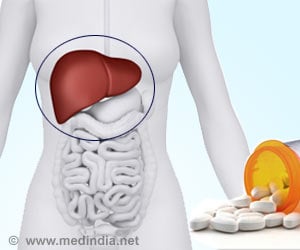High rates of virological response in patients chronically infected with hepatitis C virus genotype 1, with new interferon-free, all-oral, 3D acting-antiviral treatment.

"Using this investigational 3D regimen, with or without ribavirin, these studies have demonstrated consistently high cure rates across a number of patient types, including the more difficult-to-treat subtype GT1a, and HCV patients with compensated cirrhosis," said EASL's Scientific Committee Member Dr. Alessio Aghemo, Gastroenterology and Hepatology Unit, Ospedale Maggiore Policlinico, University of Milan. "The impressive SVR12 results seen are consistent with the results from AbbVie's phase II studies," he added.
In the SAPPHIRE-I study, treatment naïve patients with chronic HCV GT1 infection and no evidence of liver cirrhosis, were given 12 weeks of treatment with the 3D regimen plus ribavirin (RBV). After 12 weeks, the overall intention-to-treat SVR12 rate was 96.2%. Even in the more difficult-to-treat subtype GT1a, which made up the majority of patients in this study, the SVR12 rate was 95.3% compared to 98% in GT1b patients.
Dr. Aghemo also presented the results from TURQUOISE-II, which demonstrated the efficacy of the 3D regimen even in HCV GT1a and GT1b patients with cirrhosis. Using an intention-to-treat analysis, in the 12 weeks treatment arm 91.8% of patients achieved SVR12; in the 24 weeks treatment arm, 95.9% of patients achieved SVR12.
Finally, a third study, PEARL-III, studying the efficacy and tolerability of AbbVie's investigational 3D regimen in treatment naïve adults with chronic genotype 1b (GT1b), and no evidence of liver cirrhosis, were randomised to receive the 3D regimen with or without (RBV). Following 12 weeks of treatment, 99.0% receiving the regimen without RBV and 99.5% receiving the regimen with RBV achieved SVR12.
"This collection of studies show encouraging data and further support our understanding of the efficacy and safety of this 3D regimen in a variety of patient types," summarised Dr Aghemo. "Such research continues to highlight the advances being made in treating complex diseases of this type."
Advertisement
Ninety-six percent SVR12 achieved in treatment naïve HCV Genotype 1 patients on investigational all-oral, interferon-free, 12-week regimen
Advertisement
In the active treatment arm, patients with GT1b infection achieved 98 percent SVR12 (148/151), while patients with the more difficult-to-treat subtype GT1a achieved 95.3 percent SVR12 (307/322).
In this intent-to-treat analysis, patients with missing values for any reason were considered treatment failures. The rate of virological relapse or breakthrough was low, occurring in only 0.2% of patients during treatment with the 3D regimen and 1.5% of patients as a post-treatment relapse.
During the double-blind period, the most common treatment-emergent adverse events in the 3D and placebo arms were fatigue (34.7% and 28.5%, respectively) and headache (33.0% and 26.0%, respectively); the frequency of these events did not differ between treatment arms (P=NS). Discontinuation rates due to adverse events were low, and an equal percentage (0.6%) in both active and placebo groups.
"GT1 (with subtypes 1a and 1b) is the most prevalent HCV genotype worldwide," said Dr. Aghemo. "There is currently a large unmet need for a safe, efficacious and simple therapy in this patient population, and this SVR12 rate is superior to the historical SVR12 rate for telaprevir and peginterferon/ribavirin," he added.
The 3D regimen consisted of the NS5B RNA polymerase inhibitor ABT-333 (250mg), ribavirin (weight-based -- 1000mg or 1200mg daily), both dosed twice daily, and the fixed-dose combination of the HCV NS3/4A protease inhibitor ABT-450 (150mg) dosed with ritonavir (100mg) (ABT-450/r 150/100mg) co-formulated with the NS5A inhibitor ABT-267 (25mg).
Study 2: TURQUOISE-II: SVR12 RATES OF 92%-96% IN 380 HEPATITIS C VIRUS GENOTYPE 1-INFECTED ADULTS WITH COMPENSATED CIRRHOSIS TREATED WITH ABT-450/R/ABT-267 AND ABT-333 PLUS RIBAVIRIN (3D+RBV)
TURQUOISE-II demonstrates efficacy of 3D regimen even in HCV GT1 patients with cirrhosis
Finally, Dr. Aghemo presented the results from TURQUOISE-II the first completed phase III study investigating an all-oral, interferon-free regimen exclusively in GT1 cirrhotic patients.
From a global study population of 380 GT1a and GT1b, treatment-naive and treatment-experienced patients with compensated cirrhosis: 208 patients were randomised to the 3D regimen with ribavirin (RBV) for 12 weeks, and 172 patients randomised to the 3D regimen with RBV for 24 weeks.
Using an intention-to-treat analysis, in the 12 weeks treatment arm 91.8% of patients (n=191/208) achieved SVR12; in the 24 weeks treatment arm, 95.9% of patients (n=165/172) achieved SVR12. The difference between the two treatment arms was not statistically significant.
Virological relapse or breakthrough was noted in around 6% of patients in the 12-week arm and around 2 percent in the 24-week arm.
The three most common adverse events in the 12-week and 24-week treatment arms were respectively fatigue (32.7% and 46.5%), headache (27.9% and 30.8%) and nausea (17.8% and 20.3%). Discontinuations due to adverse events were noted in approximately 2% of subjects in both treatment arms. The safety profile was consistent with results in non-cirrhotic populations using the 3D with RBV regimen.
Study 3: PEARL-III: 12 WEEKS OF ABT-450/R/267 + ABT-333 ACHIEVED SVR IN >99% OF 419 TREATMENT-NAÏVE HCV GENOTYPE 1B-INFECTED ADULTS WITH OR WITHOUT RIBAVIRIN
PEARL-III demonstrates efficacy of 3D regimen with or without ribavirin for treatment of HCV GT1b-infected, non-cirrhotic, treatment-naive adults
This 419-patient studied 3D regimen with or without ribavirin (RBV), in adults with chronic genotype 1b (GT1b) who were new to treatment and had no evidence of liver cirrhosis. Following 12 weeks of treatment, 99.0 percent receiving the 3D regimen with placebo in place of RBV (n=207/209) and 99.5 percent receiving the regimen with RBV (n=209/210) achieved SVR12. High response rates were observed across all HCV GT1b patients in the study, including those patient populations with those characteristics (male gender, Black race and IL28B non-CC genotypes) historically associated with having a decreased response to treatment.
No on-treatment virological failures occurred in the treatment arm without RBV and one single virological failure occurred in the treatment arm with RBV. Across both treatment arms, there were no documented relapses within 12 weeks post-treatment.
Source-Eurekalert










